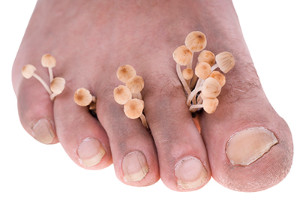Douglas Pacaccio, DPM
Thomas Nordquist, DPM
Where Does Athlete’s Foot Develop?
Tuesday, 28 May 2019 00:00 The area of the foot that is most often affected with athlete’s foot is between the toes. This condition is typically caused by a fungal infection that enters the body through tiny cracks in the skin. It generally thrives in warm and moist environments, that include public pools, shower room floors, and surrounding areas. Some patients have existing medical conditions and may make them more likely to contract athlete’s foot. These may include poor circulation, skin conditions such as eczema, or sweaty feet. There are methods that can be implemented which may help to prevent athlete’s foot. These can consist of wearing appropriate shoes while in public areas, frequently washing socks and bedding, and to avoid sharing socks and shoes. For mild cases of athlete’s foot, treating the affected area with an antifungal spray may provide moderate relief. If this condition becomes severe, it is suggested to schedule an appointment with a podiatrist who can properly treat this condition.
The area of the foot that is most often affected with athlete’s foot is between the toes. This condition is typically caused by a fungal infection that enters the body through tiny cracks in the skin. It generally thrives in warm and moist environments, that include public pools, shower room floors, and surrounding areas. Some patients have existing medical conditions and may make them more likely to contract athlete’s foot. These may include poor circulation, skin conditions such as eczema, or sweaty feet. There are methods that can be implemented which may help to prevent athlete’s foot. These can consist of wearing appropriate shoes while in public areas, frequently washing socks and bedding, and to avoid sharing socks and shoes. For mild cases of athlete’s foot, treating the affected area with an antifungal spray may provide moderate relief. If this condition becomes severe, it is suggested to schedule an appointment with a podiatrist who can properly treat this condition.
Athlete’s foot is an inconvenient condition that can be easily reduced with the proper treatment. If you have any concerns about your feet and ankles, contact one of our podiatrists from Advanced Foot and Ankle Surgeons, Inc. . Our doctors will treat your foot and ankle needs.
Athlete’s Foot: The Sole Story
Athlete's foot, also known as tinea pedis, can be an extremely contagious foot infection. It is commonly contracted in public changing areas and bathrooms, dormitory style living quarters, around locker rooms and public swimming pools, or anywhere your feet often come into contact with other people.
Solutions to Combat Athlete’s Foot
- Hydrate your feet by using lotion
- Exfoliate
- Buff off nails
- Use of anti-fungal products
- Examine your feet and visit your doctor if any suspicious blisters or cuts develop
Athlete’s foot can cause many irritating symptoms such as dry and flaking skin, itching, and redness. Some more severe symptoms can include bleeding and cracked skin, intense itching and burning, and even pain when walking. In the worst cases, Athlete’s foot can cause blistering as well. Speak to your podiatrist for a better understanding of the different causes of Athlete’s foot, as well as help in determining which treatment options are best for you.
If you have any questions please feel free to contact one of our offices located in Sycamore, and Yorkville, IL . We offer the newest diagnostic and treatment technologies for all your foot and ankle needs.
Featured Articles
- April 2024
- March 2024
- February 2024
- January 2024
- December 2023
- November 2023
- October 2023
- September 2023
- August 2023
- July 2023
- June 2023
- May 2023
- April 2023
- March 2023
- February 2023
- January 2023
- December 2022
- November 2022
- October 2022
- September 2022
- August 2022
- July 2022
- June 2022
- May 2022
- April 2022
- March 2022
- February 2022
- January 2022
- December 2021
- November 2021
- October 2021
- September 2021
- August 2021
- July 2021
- June 2021
- May 2021
- April 2021
- March 2021
- February 2021
- January 2021
- December 2020
- November 2020
- October 2020
- September 2020
- August 2020
- July 2020
- June 2020
- May 2020
- April 2020
- March 2020
- February 2020
- January 2020
- December 2019
- November 2019
- October 2019
- September 2019
- August 2019
- July 2019
- June 2019
- May 2019
- April 2019
- March 2019
- February 2019
- January 2019
- December 2018
- November 2018
- October 2018
- September 2018








